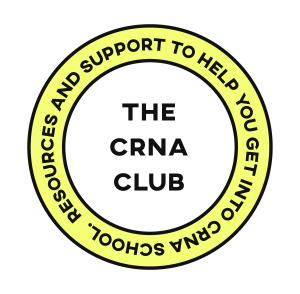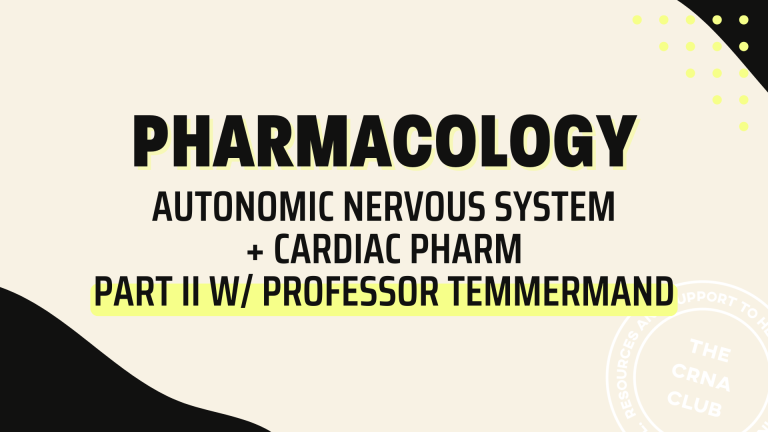
PREOPERATIVE ASSESSMENT
Related Resources + Files

- Follow @Atomic_Anesthesia for some educational content!
- The History of the AANA
A big part of what we do as anesthesia providers starts with a preoperative assessment. In the preoperative area, you’ll see CRNAs ask specific questions, and do specific assessments – watch this lesson if you’re going into your shadow experience or just want to know a bit more about what happens in preop in regards to the CRNA’s role.
ANESTHESIA BASICS
AM I EXPECTED TO KNOW THIS STUFF?
Absolutely not! But why are we sharing this with you? It’s so you can walk into your shadow experiences with some basic understanding of the lingo and the events/flow of the OR. We hope by having a basic understanding you’ll be able to formulate thoughtful questions to the CRNAs you engage with, and you’ll be able to really absorb the role of the CRNA a tad better.
Plus, by having this basic understanding of some anesthesia terms and facts, you will be able to think about your DNP project ideas a bit better. Why is this important? Many programs will ask you to discuss this in your essay, and may even ask in your interview what you want to study. By going through these lessons and having even just a little knowledge, you’ll be better able to understand what might make a good DNP project. You can also watch the videos about the DNP project by Professor Temmermand found under the “Essay” category called, “All About the DNP Project + Ideas with Faculty Member Professor Temmermand.”
MAC VS. MAC
So there are two MAC terms you might hear. One is a billing term, and another is in reference to the depth of anesthesia. Confusing…I know. So let’s break it down.
The billing term/type of anesthesia “MAC” – means “monitored anesthesia care”. You might hear this in reference to what type of anesthesia the patient is getting – “Is this patient getting a general anesthetic or a MAC?” At a high level, this means the patient is going under sedation (not general anesthesia). It involves varying levels of sedation and analgesia tailored to the patient’s needs, ensuring comfort and safety while allowing the patient to maintain spontaneous ventilation and responsiveness. The patient typically maintains their own airway (no LMA or ETT) and the depth is lighter than a general anesthetic which means faster recovery.
The depth of anesthesia “MAC” – this stands for Mean Alveolar Concentration. In this context, MAC is the concentration of an inhaled anesthetic in the alveoli of the lungs that prevents movement (immobility) in response to a surgical stimulus (like an incision) in 50% of patients. It’s a standard measure of anesthetic potency. On the anesthetic machine, you’ll see the CRNA adjust the anesthetic gas up and down, sometimes as high as 1.0 or 1.2 MAC (or more) when we want them “deeper”, and then down to 0 when we want them to wake up (the reality is patients start to move/stir before we get them to 0 MAC, you’ll see!)
So at a MAC of 1.0 – 50% of patients will move/respond to surgical stimulus – that’s the definition. But remember, by the time the surgeon makes incision, they’ve got way more than just anesthetic gas on board – they’ve got Fentanyl, Versed, maybe some Precedex or Ketamine. That means they might need less gas (than a MAC of 1.0) in order to not move in response to surgical stimulus. Plus, many times they’re relaxed (aka paralyzed).
A bit more in depth about MAC if you're curious
- Each inhalational agent has its own MAC value. For example:
- Sevoflurane: ~2.0%
- Isoflurane: ~1.2%
- Desflurane: ~6.0%
- Nitrous Oxide: ~104%
- A lower MAC value means the anesthetic is more potent (e.g., isoflurane is more potent than desflurane).
- So if we are aiming to achieve a MAC of 1.0 – you might see the CRNA dial up the Sevoflurane to about 2%. If we are using Desflurane- they might turn up the Desflurane dial to about 6%!
- The MAC value guides how much anesthetic gas is delivered. For example:
- 1 MAC is the concentration needed to prevent movement in 50% of patients.
- 1.3 MAC prevents movement in ~95% of patients (commonly targeted in general anesthesia).
- 0.5 MAC or lower might be used for sedation in combination with other agents.
- Factors That Affect MAC: Several factors can increase or decrease a patient’s MAC requirement:
- Increase MAC (Need More Anesthetic):
- Young age (highest in infants around 6 months)
- Hyperthermia
- Chronic alcohol use
- CNS stimulants
- Decrease MAC (Need Less Anesthetic):
- Older age
- Hypothermia
- Pregnancy
- Hypoxia or severe anemia
- Co-administration of other sedatives or opioids
- Increase MAC (Need More Anesthetic):
You also might like...
Some related quick reads...
Take a listen TO THESE RELATED PODCAST EPISODES:




